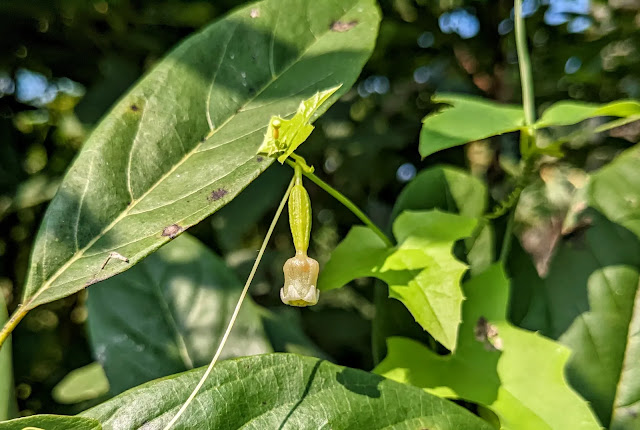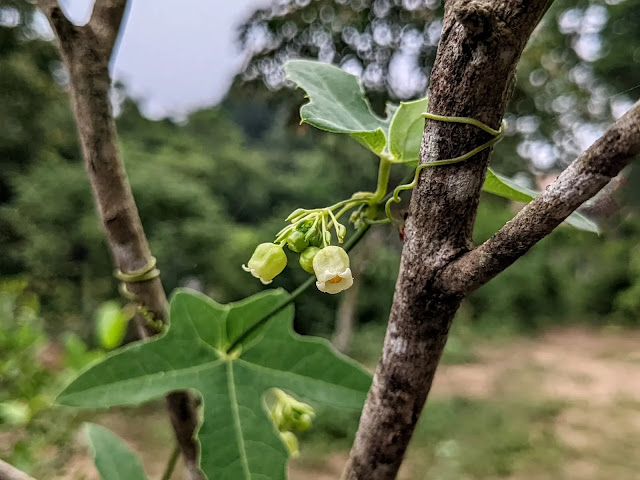Introduction
One of my cousins from northern Andhra Pradesh used to praise a particular vegetable called Nethi Donda(నేతిదొండ) , a local Telugu name. He said they had failed to propagate it and mentioned that it is very difficult to propagate. According to him, it is available only in a particular season. People generally collect the vegetable in the wild and sell it in local markets, where it is available in very limited quantities and the price is generally high. He had tried to transplant the plant and grow it from seeds, but neither method worked for him. This information increased my curiosity, and I wanted to grow it in my hometown. It is very interesting to me to understand that the only thing we can do is collect it from the wild. I was not very convinced about the propagation part; it may be difficult, but not impossible.
Discovery in the Backyard
I was in the backyard of my house in my hometown, looking at the tamarind tree where I had attached an orchid, checking its growth. I saw a fruit hanging that looked like a wild ivy gourd. My gardener told me it was a small variety of ivy gourd, and he said it is edible and that he used to eat it whenever he found it. I hadn’t closely examined the fruit and was under the impression that it was just a wild ivy gourd, as this plant is very common.
 |
| Raw Fruit on the Sweetsop tree |
Realization and Identification
A few years later, I was casually walking in the backyard of my hometown when a fruit caught my attention on a custard apple tree. It looked like an ivy gourd at first glance, but upon closer inspection, I noticed it was slightly different. The flowers and leaves were also a bit different from those of a wild ivy gourd. I was extremely curious about this fruit. I took some photos of the fruit, leaves, and flowers to post on online forums for help identifying it. I saw that people often misidentified this as ivy gourd. When I tried to recall the properties my cousin mentioned for the Nethi Donda, they matched this fruit. I sent the photos to him, and he identified it as Nethi Donda. He was surprised to find it growing in my hometown backyard, as he had also lived here for a few years. The next thing I did was check with my gardener, who confirmed that it was the same fruit he had referred to as a small ivy gourd. I showed him the fruit, and he confirmed it was the same. Since he was very sure this vegetable was edible, I decided to try eating the fruit.
 |
| Some fruits are round in shape, differing from the usual oval shape |
Observations and Learnings
The fruit tastes good; it is mildly sweet and has a buttery flavour. Interestingly, it has round seeds. Initially, it looked like a close relative of the ivy gourd, but it is very different, as ivy gourd has tiny, flat seeds similar in shape to cucumber seeds. I also tasted the raw fruit, which had a flavour somewhat like coconut. I was super excited to discover this vegetable I had been curious about for a long time, right in my hometown backyard. My next action was to check if there were any more plants nearby and see how common it is. To my surprise, I found another nearby plant with many flowers but no fruits at all. However, the plant looked the same. This piqued my interest further, so I decided to take a closer look at both plants and identify any differences. An individual flower looked exactly the same on both plants. I noticed one difference: the plant without fruits had flowers in clusters, whereas the one with fruits had individual flowers. After some research, I realised that the plant without fruits might be a male plant, which only has flowers. I found a few more plants nearby, both male and female, and noticed that female plants always had some fruits. It became clear to me that this plant species has distinct male and female plants, with males providing pollination. Interestingly, the female plant seems to self-pollinate. Later, I found a few more in my backyard and wondered how I had missed them all these years.
 |
| Female flower |
 |
| Male flowers always appear in clusters |
Successful Propagation
The next step is to encourage the plants in my backyard and try propagating more via seeds. We have collected a few seeds and tried to propagate them. Contrary to what my cousin said about their failed attempts to propagate, many seeds germinated. Currently, a few plants are growing healthily. This plant is a creeper with very thin stems and never overgrows the host plant. During the season, I observed very few fruits per plant, which means you need many plants to make a curry from this. Now I realise why it is rare and expensive. Overall, this is a great plant that can be used as both a vegetable and a fruit. A few more observations: The fruit grows very fast and ripens within a few days. If you want to collect vegetables, you need to watch out every day. This fruit is a favourite of many birds, and I still need to identify which bird species consume it. If you are lucky, you might find a fruit that has not been eaten by birds. After some research over many days on the internet, I found the scientific name: Solena amplexicaulis (Synonym: Solena heterophylla) , also known in English as the Himalayan Creeping Cucumber.
Conclusion
Overall, this finding is very exciting, and I want to continue my observations and share my experiences.
Comments
Post a Comment